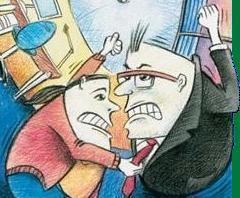
“Everyone does what he can’t do.”
(Christine Wohlfahrt in “Dilldöppchen”)
Team Building
Christine, my wife, has made cabbage rolls with a millet filling, creamed potatoes. We also have a big bowl of salad. She has taken the idea for the filling from the meat department in the super market. The Manager is vegetarian and recently, she sold her rissoles made from millets. Chris doesn’t care much about vegetarianism, but if it’s tasty, so, why not …
“You’re not at all here! I might as well eat alone.” Chris is disappointed that I don’t praise her meal, but am staring into the air.
I tell her of my ideas with the Investigation Group. Then the conversation moves to the July kick-off meeting.
“Remember, when you went on top of the climbing wall with Buchenstab slippers”, Chris laughs.
It was a little different, but it was close: Ringolf hadn’t wanted to tell exactly, what kind of a program he had planned. There was supposed to be some surprise. But we were to take heavy mountain boots with us. Nevertheless, I didn’t care to do that because I had ruined my toenails with such boots (I couldn’t walk a step without pain for weeks.) I have been going to the mountains only with Buchenstab slippers for many years. I wear boots only when there are big pebbles, in the snow and at real climbing tours.
I thought they had planned such a walking tour. For that I did not want to drag heavy footwear with me. Instead, we were standing in front of a sportive climbing wall. Not very difficult, but the steps were quite small. I borrowed boots from a colleague with the same shoe size. Otherwise, I would have had to stay on the ground. Then there were catwalks and stretched ropes between trees at a height of ten yards. There were also loose-hanging ropes and all such play things as you may find on an adventure playground. Cables to engage the spring hooks of the climbing belts were above it. We safely kept our balance. Naturally, my colleague needed his boots himself. So – just not to leave myself wide open for remarks – I defied death and climbed the ropes wearing my Buchenstab slippers. I only hoped that the slippers would remain on my the feet so that I would not make a fool of myself. In any case, it worked surprisingly well.
“You also balanced on a pasteboard bridge”, Chris reminds me.
“Yes, that was the team building exercise”, I say. "We were supposed to build a bridge of paper and cardboard that was fit to carry at least one person. And there should be enough space for two Euro Boxes underneath. Those were the requirements. Other than that, no requirements interfered with our the inventiveness.
Mr. Dr. Wilfried Wagner himself immediately volunteered as manager for the bridge building project. (Perhaps others would have liked that job, but I suppose, they didn’t want to step forward too forcefully.) Stefan Schwarz, our hardware specialist, designed the horizontal columns with a triangular sectional view of the catwalk. We folded and glued like kindergarten kids. Others joined. Some cut cardboards to size for a crossing way. While we discussed the best design, Suad Brazzi rolled magazines into short compact sticks. The sticks turned out to be very helpful for stabilizing the triangular columns, which otherwise threatened to fold when we tried to walk on the bridge.
“Nobody but mathematicians and specialists at work …”, Chris laughs.
“… and the bridge lasted”, I complete contently. At that time I had climbed it quite cautiously. Then two others put their weight on it, and then another one. Finally, six people were on the bridge. However, at that point I felt a bit queasy. It wasn’t likely to bear more. It already faltered quite dangerously.
Later I heard, that Umberto had proposed a substantially simpler construction: Put some cardboard sheets over the two Euro Boxes and: ready. But the others had a different image of what a bridge should look like. To think out of the box isn’t really common for us nerds.
In the evening with a beer, Umberto said: “People think that a cardboard bridge has to be similar to a real bridge. But that wasn’t required at all. My proposal would have satisfied the requirements.” I agreed with Umberto.
“It’s actual a pity”, I reflect on that today to Chris, “that we so often do not recognize the value of resourceful ideas and that our thinking stays in the same old rut.”
Translated from: Marinus Münster, “Dilldöppchen”, Publishing House: Geest-Verlag 2004